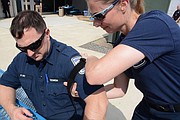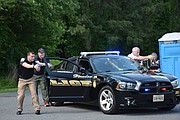Herndon Police Officers practice their first response medical skills during a training session with the Fairfax County Fire & Rescue Department. Photo by Tim Peterson.
Two menacing Dodge Charger sedans come to a stop, a dark silver one in front of the other, all black with gold lettering that reads Herndon Police.
Officers from the cruiser get out, and begin barking commands at the driver of the suspicious car in front. Two men quickly emerge from the silver charger, turn and begin firing at the officers. The officers return fire, dropping both of the men.
The officers begin to check on the men, bringing over a backpack full of emergency medical supplies including tourniquets and chest dressings. Once the “hot zone” scene is secure, the simulation is over and it’s another group’s turn.
The entire Town of Herndon Police Department has been undergoing emergency medical training from Fairfax County Fire & Rescue, which also serves Herndon.
Overall, officers went through four training sessions, including the May 26 exercises held at the Fairfax County Fire & Rescue Academy in Fairfax which were open to the media.
“Time is life,” Fairfax County Fire & Rescue Lt Bruce Stark said to a group of Herndon officers. “You’ve got to stop the bleeding.”
The main goal of the training was to teach officers additional life-saving skills so they can better prevent themselves, victims or suspects from dying from a traumatic injury before emergency medical professionals can get to the scene.
Uncontrolled hemorrhage is a leading cause of death for police officers, Stark said.
Herndon police spokesperson Jane Ross said the department hasn’t lost any officers in the last few years, but did have six officer injuries in 2015.
Herndon Chief of Police Maggie DeBoard cited national and international events where police were the victims of attacks. She said she wants her department to “try and stay ahead of this.”
“Officers take it for granted with medical care so close to us,” DeBoard said. “This allows us to take care of more effectively.”
Lt Steve Thompson with DeBoard’s department agreed with the chief that in the context of people having great access to weapons, “It’s a good thing to do this,” learning more first response techniques for trauma.
“We’re not performing surgery out there,” Thompson said. “You do what we can to stop bleeding. Keep it simple when under stress is the best way to go. Your fine motor skills start to deteriorate.”
Herndon Senior Police Officer Denise Randles appreciated the hands-on aspect of the training, which included life-like mannequins. The 180-pound human figures were controlled by an operator and capable of making sounds, simulating breathing, bleeding and losing appendages.
“It gets us exposed to it,” Randles said, acknowledging that experiencing shock when working with a trauma victim makes it hard to stay focused. One of the goals of the training was to make the scenarios more life-like, so officers would “already have the image,” said Randles.
“Nothing is by the book,” she said.


